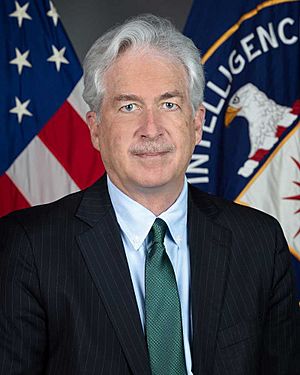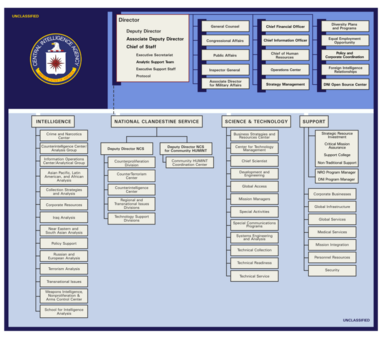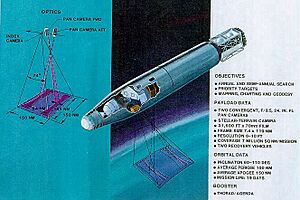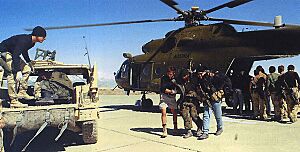Central Intelligence Agency facts for kids
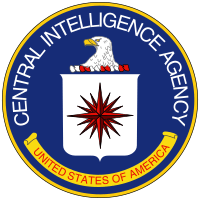
Seal of the Central Intelligence Agency
|
|
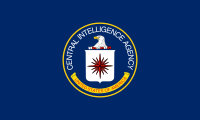
Flag of the Central Intelligence Agency
|
|
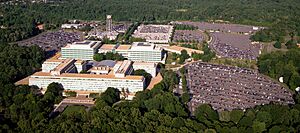 CIA headquarters, Langley, Virginia |
|
| Agency overview | |
|---|---|
| Formed | September 18, 1947 |
| Preceding agency | |
| Type | Independent (component of the Intelligence Community) |
| Headquarters | George Bush Center for Intelligence Langley, Virginia, U.S. 38°57′07″N 77°08′46″W / 38.95194°N 77.14611°W |
| Motto | (Official): The Work of a Nation. The Center of Intelligence. (Unofficial): And ye shall know the truth and the truth shall make you free. (John 8:32) |
| Employees | 21,575 (estimate) |
| Annual budget | $15 billion (as of 2013[update]) |
| Agency executives |
|
| Parent department | Office of the President of the United States |
| Parent agency | Office of the Director of National Intelligence |
| Child agencies |
|
The Central Intelligence Agency (CIA) is a special agency of the federal government of the United States. Its main job is to gather and understand information about other countries. This information helps protect the national security of the United States. The CIA mostly gets its information from human sources (people). It also carries out secret actions when the President asks.
The CIA is a key part of the United States Intelligence Community. It shares its findings with the President and the Cabinet. Unlike the Federal Bureau of Investigation (FBI), the CIA does not enforce laws inside the U.S. Its focus is on gathering intelligence from overseas. The CIA also helps set up intelligence services in other countries. For example, it helped Germany create its BND.
The CIA was created after World War II. President Harry S. Truman formed the Central Intelligence Group in 1946. This group became the CIA in 1947 with the National Security Act of 1947. Since 2004, the CIA works under the Director of National Intelligence. After the September 11 attacks, the CIA grew bigger. In 2013, it had the largest budget among all U.S. intelligence agencies. The CIA has also started doing more secret paramilitary operations. Its Information Operations Center now focuses on cyber operations.
The agency has faced some disagreements over the years. These include claims about listening in on people and spreading information within the U.S. There have also been concerns about human rights. In 2022, it was found that the CIA still has a domestic surveillance program. This program does not have direct approval from Congress.
Contents
- What the CIA Does
- How the CIA is Organized
- Training
- Budget
- Working with Other Intelligence Agencies
- History of the CIA
- Open-Source Intelligence
- Outsourcing and Privatization
- Images for kids
- See also
What the CIA Does
When the CIA was first created, its goal was to gather and analyze information about foreign policy. Today, its main jobs are to collect, understand, and share foreign intelligence. It also carries out secret operations.
The CIA has five main goals, according to its 2013 budget:
- Counterterrorism: Stopping terrorism.
- Nonproliferation: Preventing the spread of weapons of mass destruction.
- Giving warnings to leaders: Alerting top officials about important events.
- Counterintelligence: Protecting U.S. secrets from foreign spies.
- Cyber intelligence: Gathering information in the digital world.
How the CIA is Organized
The CIA has an executive office and five main parts called directorates:
- The Directorate of Digital Innovation
- The Directorate of Analysis
- The Directorate of Operations
- The Directorate of Support
- The Directorate of Science and Technology
Executive Office
The director of the Central Intelligence Agency (D/CIA) is chosen by the President. The Senate must approve this choice. The Director reports to the Director of National Intelligence (DNI). The deputy director helps manage the CIA's daily work. The Executive Office also helps the U.S. military. It shares information and works with military intelligence groups.
Directorate of Operations
The Directorate of Operations collects foreign intelligence. It mainly uses secret human sources. This part of the CIA also carries out secret actions. It helps coordinate human intelligence activities across the U.S. intelligence community. This directorate is organized by different regions and issues. However, its exact structure is kept secret.
Directorate of Science & Technology
This directorate was created to develop new technologies. It focuses on tools and equipment for gathering information. Many of its inventions have been shared with other intelligence groups. Some have also been given to the military.
For example, the U-2 spy plane was developed with the United States Air Force. The U-2's first job was to take secret pictures over places like the Soviet Union. Now, the Air Force operates it.
Directorate of Support
The Directorate of Support handles the CIA's daily operations. It manages important offices like:
- The Office of Security
- The Office of Communications
- The Office of Information Technology
Directorate of Digital Innovation
The Directorate of Digital Innovation (DDI) is the newest part of the CIA. It focuses on making the agency better at using digital tools. Its goal is to bring digital and cybersecurity skills into the CIA's work. This includes spying, stopping spies, and analyzing information. It also helps CIA officers use tools for cyber operations. This directorate helps the CIA prepare for cyberwarfare.
The DDI started working in October 2015. In 2013, the CIA's budget for computer network operations was $685.4 million.
Training
The CIA opened its first training facility in 1950. After the Cold War, training funds were cut. This made it harder to keep employees. In response, George Tenet started CIA University in 2002. CIA University offers many courses each year. It trains new hires and experienced officers. It also trains support staff.
The CIA has secret training areas. One is at Camp Peary in Virginia. Another is at Harvey Point in North Carolina. The main training facility for communications is the Warrenton Training Center in Virginia.
Budget
The exact details of the U.S. intelligence budget are secret. However, some information has been shared. The Central Intelligence Agency Act of 1949 allows the CIA Director to spend government money without showing all the details.
In 2013, the CIA's budget was $14.7 billion. This was about 28% of the total intelligence budget. It was also almost 50% more than the budget of the National Security Agency (NSA). About $2.3 billion was for human intelligence (HUMINT). Another $1.7 billion was for signals intelligence (SIGINT). About $2.5 billion was for security and logistics. "Covert action programs," like the CIA's drone fleet, cost $2.6 billion.
Working with Other Intelligence Agencies
Foreign Intelligence Services
The CIA works with intelligence agencies in other countries. These include Germany's Federal Intelligence Service (BND) and the United Kingdom's Secret Intelligence Service (MI6). It also works with Australia's ASIS and Canada's CSIS.
The U.S. intelligence community has very close ties with English-speaking countries. These are Australia, Canada, New Zealand, and the United Kingdom. They share intelligence messages easily. This group is often called the Five Eyes.
History of the CIA
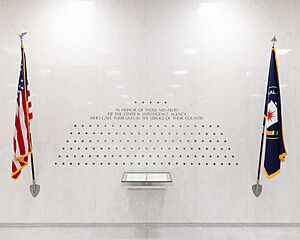
The Central Intelligence Agency was officially created on July 26, 1947. President Harry S. Truman signed the National Security Act of 1947. A big reason for creating the agency was the growing tension with the Soviet Union after World War II.
Early Years and Challenges
Before the CIA, there was the Office of Strategic Services (OSS). President Franklin D. Roosevelt created the OSS during World War II. After the war, President Truman closed the OSS. Its jobs were split between the State and War Departments. But this didn't last long. In 1946, Truman created the Central Intelligence Group (CIG). This group was the direct ancestor of the CIA.
The National Security Act of 1947 officially created the CIA. It also set up the National Security Council. In 1949, the Central Intelligence Agency Act was passed. This law allowed the CIA to keep its financial and administrative procedures secret. It also allowed the CIA to keep its staff details private.
In its early days, the CIA faced challenges. It struggled to provide clear warnings about events like the Soviet atomic bomb project. It also failed to predict China's entry into the Korean War.
Secret Operations and Influence
The CIA had two main jobs: gathering secret information and carrying out secret actions. One of its early successes was influencing the 1948 Italian general election in favor of the Christian Democrats. The CIA used funds to help Italian politicians. This tactic of using money to influence elections was repeated many times.
Korean War
During the Korean War, the CIA tried to create a guerrilla force of North Korean exiles. These agents were supposed to gather information and fight. However, many of these efforts failed. Internal reviews later found that much of the information from these sources was false.
1953 Iranian Coup
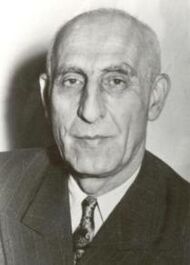
In 1951, Mohammad Mosaddegh became Iran's prime minister. He nationalized the British-owned oil industry. This caused problems for Iran. In 1953, Mosaddegh took more power, which led to the Shah trying to remove him. Mosaddegh then launched a military takeover, and the Shah fled.
Under CIA Director Allen Dulles, Operation Ajax began. Its goal was to overthrow Mosaddegh and bring back a pro-Western government. The CIA helped organize protests and paid people to cause trouble. This led to Mosaddegh's downfall and the Shah's return.
1954 Guatemalan Coup
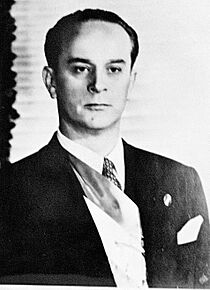
The success in Iran led to Operation PBSuccess in Guatemala. This plan aimed to overthrow Guatemalan President Jacobo Arbenz. Arbenz's government was giving land to poor farmers. This threatened the United Fruit Company, a large American company. The company asked the U.S. government for help.
In June 1954, Carlos Castillo Armas led 480 CIA-trained men into Guatemala. The CIA also used radio broadcasts to spread false information. A CIA plane bombed Guatemala City. Arbenz resigned, and Castillo Armas became president. This led to a long and brutal Guatemalan Civil War.
Syria and Indonesia
The CIA was involved in a coup in Syria in 1949. Later, in 1957, a CIA agent was caught trying to overthrow the Syrian government. This caused problems between the U.S. and Syria.
In Indonesia, the CIA tried to overthrow President Sukarno in the late 1950s. Sukarno wanted Indonesia to be neutral in the Cold War. The CIA sent weapons and supported a revolution. A CIA pilot was shot down and captured. This operation also failed.
Congo and U-2 Incident
In the Democratic Republic of the Congo, the CIA saw Prime Minister Patrice Lumumba as a threat. President Dwight D. Eisenhower ordered Lumumba to be "eliminated." Lumumba was later imprisoned and killed in 1961.

In 1960, a U.S. U-2 spy plane was shot down over the Soviet Union. This caused a big international incident. President Eisenhower had hoped for better relations with the Soviet Union. The U-2 incident damaged these hopes.
Bay of Pigs Invasion
The Bay of Pigs Invasion was a failed attempt to overthrow Fidel Castro in Cuba. In 1961, a CIA-backed group of Cuban exiles tried to invade Cuba. The invasion failed within three days. This was a major embarrassment for U.S. foreign policy. It also strengthened Castro's ties with the Soviet Union.
After this failure, the CIA planned more secret actions against Cuba. These included sabotage and terrorist attacks. These actions caused more tension between the U.S. and Cuba. They also contributed to the Cuban Missile Crisis in 1962.
Cold War Operations (1953–1989)

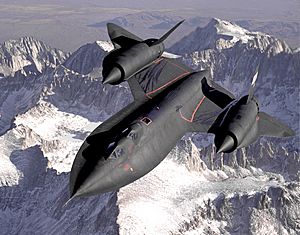
The CIA was involved in many anti-Communist activities during the Cold War. These included operations in Burma, the Congo, Guatemala, and Laos.
Brazil
The CIA was involved in the 1964 Brazilian coup d'état. This coup removed President João Goulart. The U.S. saw Goulart as a left-wing threat. The CIA encouraged "pro-democracy street rallies" to create opposition against him.
Vietnam War
During the Vietnam War, the CIA had many operations. It tried to gather intelligence and carry out secret missions. Some of these efforts, like Project Tiger, failed. The CIA also started a domestic surveillance program called Operation CHAOS. This program watched antiwar groups in the U.S.
Nixon Era and "Family Jewels"
During the Nixon presidency, the CIA faced more scrutiny. Some former CIA officers were involved in the Watergate burglary. President Nixon tried to use the CIA to stop the FBI's investigation.
This led to the discovery of the "Family Jewels." These were secret documents about past CIA activities. They included information about attempts to kill foreign leaders. They also showed illegal spying on U.S. citizens. This led to investigations by Congress and a presidential commission. President Gerald Ford then banned the assassination of foreign leaders.
Afghanistan
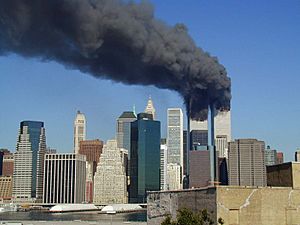
In Afghanistan, the CIA sent billions of dollars in weapons to Afghan mujahideen fighters. This was to help them fight the Soviets during the Soviet–Afghan War. These weapons, like FIM-92 Stinger missiles, sometimes ended up on the black market.
Poland
The Reagan Administration supported the Solidarity movement in Poland. The CIA secretly sent money and equipment to Solidarity. This helped the movement against the communist government.
Operation Gladio
During the Cold War, the CIA was involved in Operation Gladio with NATO. This operation supported anti-communist groups in Italy and Turkey.
Fall of the USSR
The CIA was surprised by the fall of the Soviet Union. Its analysis of the Soviet economy and military was often wrong. This was partly because few officers spoke Russian or had visited the country.
Post-Cold War (1990s)
Bosnian War and Embassy Bombing
During the Bosnian War, the CIA was slow to confirm the Srebrenica massacre. It took weeks for the agency to verify the mass killings. Another mistake happened during the NATO bombing of Serbia. The CIA incorrectly identified the Chinese Embassy as a military target, leading to its bombing.
Aldrich Ames
Between 1985 and 1986, the CIA lost many spies in Eastern Europe. In 1994, it was discovered that Aldrich Ames, a CIA officer, was spying for Russia. This revealed that much of the CIA's information about the USSR was false.
Osama bin Laden and 9/11
The CIA had been tracking Osama bin Laden since 1996. In 1999, CIA chief George Tenet launched a plan to deal with al-Qaeda. The CIA used drones to gather information on bin Laden in Afghanistan.
On September 11, 2001, al-Qaeda carried out terrorist attacks in the U.S. These attacks led to a huge increase in applications for CIA jobs. The CIA became a key part of the "War on Terror." It worked with anti-Taliban groups in Afghanistan. A CIA officer, Johnny "Mike" Spann, was the first American to die in combat in Afghanistan.
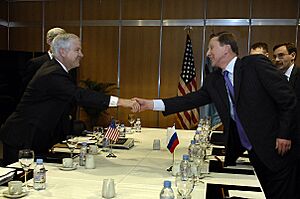
The CIA was criticized for not preventing the 9/11 attacks. However, the agency said its efforts helped it respond quickly.
Iraq War
Before the Iraq War, the CIA had networks of spies in Iraq. However, the information used to justify the war was later found to be inaccurate. For example, claims about Iraq's weapons of mass destruction (WMD) were based on unreliable sources. The invasion itself was a difficult time for the CIA.
Changes After 2004
The Intelligence Reform and Terrorism Prevention Act of 2004 created the office of the Director of National Intelligence (DNI). The DNI took over some of the CIA's top-level jobs. Before this, the CIA Director oversaw all U.S. intelligence. Now, the CIA Director reports to the DNI.
Operation Neptune Spear
On May 1, 2011, Osama bin Laden was killed in Abbottabad, Pakistan. This was a CIA operation. It involved U.S. Navy special forces and CIA paramilitary officers. The operation was the result of years of intelligence work. The CIA used a fake vaccination clinic to try to find bin Laden. This caused problems for vaccination efforts in Pakistan.
Syrian Civil War
The CIA has been involved in the Syrian Civil War since at least 2012. It trained and armed rebel fighters against the Syrian government. However, some of these weapons reportedly fell into the hands of extremist groups. In 2017, U.S. support for these rebels was phased out.
Reorganization
In 2015, the CIA announced major changes. It created the new Directorate of Digital Innovation. This directorate focuses on digital technology and cybersecurity. It also expanded CIA University for training. The agency also created "Mission Centers." These centers bring together different parts of the CIA to focus on specific regions of the world. The National Clandestine Service was renamed the Directorate of Operations. The Directorate of Intelligence was renamed the Directorate of Analysis.
Drones and Encryption
President Donald Trump allowed the CIA to launch drone strikes on suspected terrorists. This reversed a policy by President Barack Obama.
For many years, the CIA secretly owned Crypto AG. This Swiss company made encryption devices. The company sold these devices to over 120 countries. This allowed Western intelligence agencies to listen in on communications.
Open-Source Intelligence
The CIA uses open-source intelligence. This means gathering information from publicly available sources. For example, the Foreign Broadcast Information Service (FBIS) used to collect and translate foreign broadcasts. Now, this is part of the National Open Source Enterprise under the DNI. The CIA also uses social media intelligence. It launched a Twitter account in 2014.
Outsourcing and Privatization
Many intelligence jobs are now done by private companies. This means former government officials sometimes do the same jobs for private companies. These jobs often pay much more. This has led to concerns about oversight and accountability. Congress has tried to address this by requiring reports on outsourcing.
The CIA has faced challenges with hiring. Many talented employees leave for higher-paying jobs with private contractors. This has led to a large number of contractors working for the CIA.
Images for kids
-
CIA director Allen Dulles on the cover of Time magazine, 1953
-
President John F. Kennedy presenting the National Security Medal to Allen Dulles, November 28, 1961
-
President Gerald Ford meeting with CIA Director–designate George H. W. Bush, December 17, 1975
- Abu Omar case
- Blue sky memo
- CIA's relationship with the United States Military
- Classified information in the United States
- Enhanced interrogation techniques
- Freedom of Information Act (United States)
- Intellipedia
- Kryptos
- National Intelligence Board
- Operation Peter Pan
- Reagan Doctrine
- Title 32 of the Code of Federal Regulations
- U.S. Army and CIA interrogation manuals
- United States and state-sponsored terrorism
- United States bombing of the Chinese embassy in Belgrade, target chosen by CIA, claimed by accident
- United States involvement in regime change
- United States Department of Homeland Security
- United States Intelligence Community
- Vault 7
- The World Factbook, published by the CIA
See also
 In Spanish: Agencia Central de Inteligencia para niños
In Spanish: Agencia Central de Inteligencia para niños


